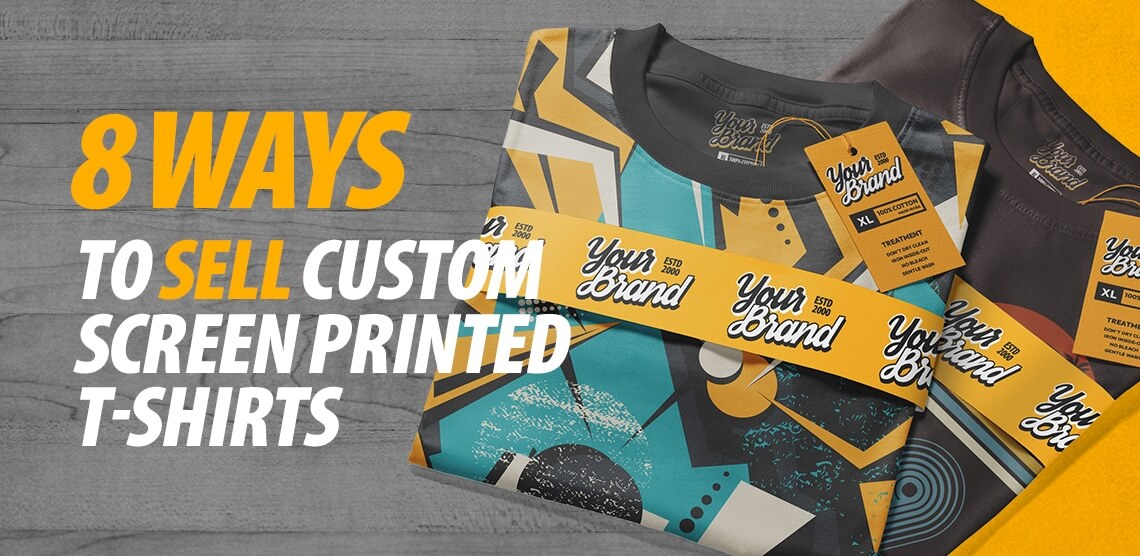Screen Printing Uncovered: Every Little Thing You Need to Learn About Tee and Garment Printing Techniques
Screen printing is an interesting method that combines art with strategy, offering countless opportunities for imagination. All set to explore the essential aspects that make screen printing an art type?
The Fundamentals of Screen Printing: Exactly How It Functions
When you plunge into screen printing, you'll discover it's both a science and an art. At its core, screen printing involves producing a stencil, or display, that allows ink to pass through only in details locations.
Following, you'll blend your inks and prepare your printing surface area. Position the screen over the textile, then make use of a squeegee to press ink through the display onto the garment. This procedure requires precision, as you desire clear, vivid prints. After printing, you'll heal the ink with warm, guaranteeing it abides by the material and lasts through cleans. Each action is crucial, and mastering them will certainly raise your display printing abilities, transforming easy garments right into special, meaningful pieces.
Sorts Of Screen Printing Methods
As soon as you grasp the basics of display printing, it's time to check out the different methods that can elevate your styles. One prominent technique is typical screen printing, where ink is pushed with a stenciled screen.
If you're going for great information, think about discharge printing. This technique removes dye from the fabric, leaving a soft, classic look. Another option is plastisol printing, known for its toughness and dazzling shades, making it a preferred for lots of brands. Lastly, try out halftone printing to create gradient impacts and elaborate layouts. Each technique has its one-of-a-kind charm, so do not hesitate to try them out to discover what matches your style best!
Essential Equipment for Screen Printing
To attain spectacular cause display printing, having the right equipment is fundamental. You'll need a durable display printing frame, which holds the mesh that moves your style onto the garment. Next off, buy top quality mops; these are vital for using ink uniformly across the display. You'll likewise call for a good exposure system to develop your screens, along with a washout booth for cleansing them after usage. A dependable warmth source, like a conveyor dryer or warm press, is vital for healing your prints to guarantee long life. Do not fail to remember a correct work area, furnished with tables and storage for your products. Protective gear, such as masks and gloves, will certainly keep you risk-free from chemicals and inks. With the right devices, you'll be well on your means to generating professional-quality prints.
Selecting the Right Inks and Products
When choosing inks and products for screen printing, you need to think about the kind of ink that functions finest for your job. Consider material compatibility to ensure your styles look terrific and last lengthy. Also, check out environment-friendly ink alternatives to make your printing procedure more lasting.
Sorts Of Display Inks
Selecting the right screen ink is important for accomplishing dynamic, durable prints that fulfill your project's needs. There are a number of kinds of screen inks to check out. Specialized inks, such as metallic or glow-in-the-dark, can add unique results to your designs.

Textile Compatibility Considerations
Comprehending fabric compatibility is important for accomplishing top quality display prints, specifically given that different products respond distinctively to numerous inks. When choosing inks, consider the fabric kind-- cotton, polyester, or blends. For cotton, water-based inks work well, supplying soft qualities and breathability. Polyester, on the other hand, frequently requires plastisol inks for far better adhesion and lively colors. You may require to use a mix of both types if you're printing on blends. Constantly evaluate your inks on sample textile to ensure they adhere properly and preserve shade honesty. Furthermore, keep in mind that textile weight and structure can influence the last result, so choosing the appropriate ink and material combo is crucial for your task's success.
Eco-Friendly Ink Options
Environmentally friendly inks are coming to be a popular selection for screen printers that want to lessen their ecological influence while preserving high quality. When selecting inks, consider water-based inks, which are less damaging and simpler to tidy up contrasted to standard solvents. These inks bond well with fabrics, supplying vibrant outcomes without toxic chemicals. You may also check out eco-solvent inks that make use of fewer unpredictable organic compounds (VOCs), making them a safer alternative for both your health and wellness and the world.
Furthermore, try to find inks made from eco-friendly sources, such as soy or vegetable-based choices. By selecting the best inks and materials, you'll not only create stunning layouts however likewise add to a more sustainable printing procedure. Make the button, and your prints will reflect your dedication to the setting!
Preparing Your Design for Screen Printing

File Style Requirements
To ensure your layout looks sharp and dynamic on fabric, you'll need to pay very close attention to file style needs for screen printing. Begin with vector data like AI or EPS, as they can be scaled without shedding quality. If you utilize raster photos, go with high-resolution data, such as TIFF or PNG, preferably at 300 DPI. Stay clear of using JPEGs, as they can lose clearness when resized. Make sure your design has a transparent background link to stop undesirable white sides on your prints. Maintain shade settings in mind; CMYK is typical for screen printing, so transform your RGB designs accordingly - screen printing kit. By following these guidelines, you'll establish your artwork up for an effective print.
Color Separation Strategies
Shade splitting up is an important step in preparing your layout for screen printing, and understanding it can significantly boost your print high quality. You'll require to damage your layout into specific shades, as each shade needs a different screen throughout printing. Start by identifying all the colors in your style and develop layers for each one. You can make use of software program like Adobe Photoshop or Illustrator to separate and different shades successfully. Be particular to conserve each layer as a different documents, commonly in a layout like TIFF or PSD. This precision not just ensures accurate shade representation but additionally enhances the printing process. By focusing on color separation, you'll accomplish expert and vibrant results in your screen-printed garments.
Resolution and Size
Accomplishing the very best lead to display printing starts with ensuring your layout has the best resolution and dimension. Preferably, your artwork must go to least 300 DPI (dots per inch) for sharp, clear prints. If you make use of reduced resolution, your end product could look amateur and pixelated.
When it concerns size, take into consideration the measurements of your print area. Style your art work to match the last print dimension, ideally creating it in the actual measurements you'll be publishing. This way, you'll avoid any type of unanticipated scaling concerns.
Always check your style in both vector and raster styles. Vector graphics can be scaled without shedding top quality, making them perfect for display printing. Preparing appropriately will assure your design looks outstanding on every garment!
Step-by-Step Display Printing Process
Screen printing is a vibrant procedure that permits you to create lively styles on different surface areas. To get going, you'll require a screen, emulsion, and your selected ink. Prepare your screen by cleaning it thoroughly. Next, use the solution equally and allow it completely dry in a dark location. When dry, expose your screen to light with your design positioned on it, which will certainly set the solution where the light hits, producing a stencil - screen printing kit.
Pour ink onto the display and utilize a squeegee to push the ink via the stencil onto the fabric. Raise the screen meticulously and allow the print dry. You have actually successfully display printed your layout.
Tips for Successful Display Printing Projects
While you're diving into your display printing jobs, bear in mind that preparation is key to success. Begin by gathering all your materials-- inks, garments, squeegees, and screens. A tidy work area aids avoid undesirable errors, so neat up prior to you begin.
Following, verify your artwork is high-resolution and correctly sized for your garment. Check your screen for appropriate direct exposure and clean it completely to stay these details clear of smudges. When blending your inks, adhere to the producer's standards to achieve the ideal uniformity.
During printing, apply also stress with your squeegee check my blog for consistent results. Don't rush; take your time to validate each print meets your standards. After printing, allow your garments completely dry completely before managing or packaging them.
Last but not least, always keep a sample of your job for future referral. This way, you can examine your progression and improve your methods gradually. Satisfied printing!

Regularly Asked Inquiries
How Long Does It Require To Establish a Display Printing Task?
Setting up a screen printing work commonly takes around 30 mins to an hour. You'll prepare the screens, mix inks, and adjust journalism. The moment varies based on intricacy and experience, so remain organized!
Can I Print on Various Material Types Making Use Of the Same Strategy?
Yes, you can publish on different fabric kinds utilizing the same strategy, however you'll need to adjust your inks and setups. Some fabrics soak up ink in a different way, so experimenting guarantees the very best results for each product.
What Are Typical Mistakes to Prevent in Screen Printing?
When display printing, prevent common blunders like utilizing the incorrect ink, ignoring proper direct exposure times, or skipping pre-press checks. Constantly evaluate your arrangement and preserve tidy screens to assure high quality results each time.
Exactly How Can I Correctly Clean and Maintain My Screen Printing Equipment?
To effectively clean and keep your screen printing tools, you ought to routinely clean screens with proper solvents, check squeegees for wear, and assure all tools are kept dust-free and dry. Uniformity improves and protects against expensive repair work efficiency.
Is Display Printing Ecologically Friendly Contrasted to Various Other Techniques?
Display printing can be more eco-friendly than other approaches, specifically if you use eco-conscious materials and water-based inks. By selecting sustainable supplies and methods, you lower waste and decrease your influence on the planet.
Screen Printing Uncovered: Everything You Required to Know Regarding Tee and Garment Printing Techniques
At its core, screen printing entails producing a stencil, or screen, that enables ink to pass through only in specific locations. Setting the screen over the material, after that utilize a squeegee to push ink through the screen onto the garment. One preferred technique is standard display printing, where ink is pushed with a stenciled screen.When selecting inks and materials for screen printing, you require to take into account the type of ink that functions best for your job.